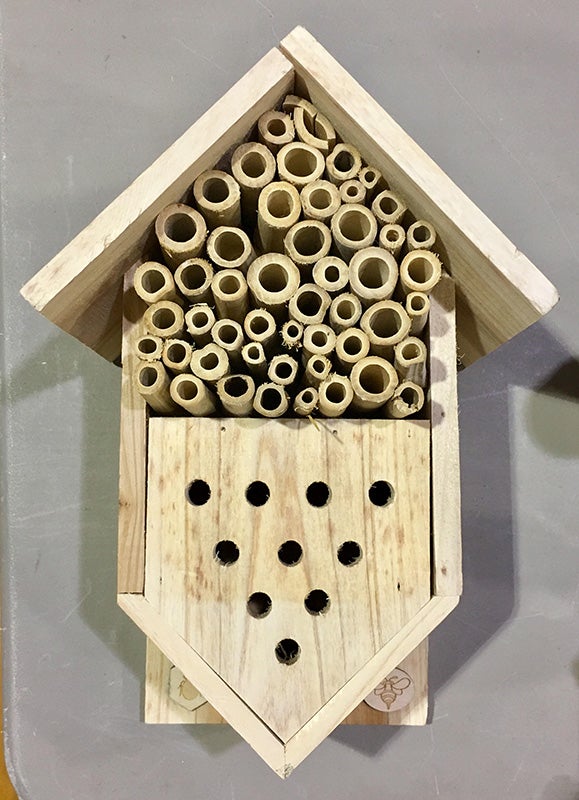Al Batt: How to help build a nest for bees by making Mason nesting blocks
Published 12:42 pm Wednesday, June 7, 2017

A man-made bees nest is much simplier than one made with honeycomb. Al Batt/Albert Lea Tribune
Al Batt of Hartland is a member of the Albert Lea Audubon Society. Email him at SnoEowl@aol.com.
My neighbor Crandall stops by.
“How are you doing?” I ask.
“Everything is nearly copa- cetic. I should have been a me- teorologist. I have hearing that would make me a great weath- erman. I can hear both thunder and lightning miles away. I love the sound of rolling thunder.
Ma always told me that it was the sound of angels bowling. Pop said that it was the sound of an old potato wagon traveling across a bridge. He said that it was piloted by an old man who caused lightning when sparks flew from his corncob pipe and that rain came from the old geezer’s tears when he wept over the low price of potatoes. My parents believed that you simplify to amplify. I even took a class on meteorology at the lo- cal college. When I took a test,
I knew the answers like the palm of my hand. That’s how I flunked that class. I was caught with the answers written on the palm of my hand.”
Naturally
I saw a barred owl on a bridge railing along rural road. A kestrel fed on a vole as the tiny falcon perched on a util- ity wire. Three deer ran into St. Aidan’s Cemetery. I tend to use cemetery and graveyard inter- changeably, but to be precise, a cemetery is a burial place for the dead that is usually located far from the church, while a graveyard is a burial place lo- cated near or beside the church or churchyard.
Lilacs bloomed. Edward Bu- nyard said that lilacs were “the very heart and soul of memo- ry.” Louise Beebe Wilder said, “My foolish heart clings to the old fashioned single purple and white, for no flower seems to me to so truly express the full- ness of spring.” Lilacs smell
like spring.
Q&A
“How can I build a nest for bees?” About 30 percent of our native bee species make their nests in beetle tunnels in snags or similar locations. The fe- male bee builds dividing walls across the tunnel to make a line of brood cells. Mason bee nesting blocks can be made by drilling nesting holes between three-thirty-seconds inch and three-eighths inch in diameter into the side of a block of lum- ber that hasn’t been treated. The holes should be smooth in- side and closed at one end (not drilled all the way through). Holes less than one-quarter inch in diameter should be 3-4
inches deep. For holes 1/4 inch or larger, drill them 5 to 6 inch- es deep. Logs and snags make great bee houses. Place them in a sunny area, some of them up- right to ensure the habitat stays dry with holes on the southeast side of each log. Stem or tube bundles can be created from plant matter or paper. Bamboo, reeds and Joe-Pye weeds have naturally hollow stems. Elder stems can be hollowed. Cut the stems in 6 to 8 inch lengths, cut- ting one end close to the stem node to create a closed end. Fif- teen to 20 stem pieces tied into a horizontal bundle with the closed ends of the stems togeth- er makes a fine nest. Or make a wooden frame with a back to hold the stems. Paper tubes work well, but make sure they stay dry. Inside the tubes, each cell is provisioned with pollen and nectar by the mother bee and a tiny egg is laid. Some species of small solitary wasps may take up residence. they furnish their cells with paralyzed live prey in- stead of pollen. Neither of these bees or wasps are prone to sting people. You could cover the holes with chicken wire to help keep birds away from the bee house.
“Do penguins fall over backward when they look up at airplanes?” they don’t topple like dominoes in the presence of flying aircraft overhead. Pen- guins are perfectly ca- pable of maintaining their footing.
“What do barn owls have to do with grapes?” Vineyard owners need to maintain constant vigi- lance over their crops. they can’t control the weather, but they can pre- vent some pests like ro- dents from damaging the plants. Some farmers use rodenticides to rid their fields of the grape-eating critters, but they are filled with harmful chemicals. Some Napa Valley pro- prietors use barn owls as a natural pest control strategy.
“Why do ostriches bury their heads in the sand when they’re frightened or threatened?” they don’t. they wouldn’t be able to breathe. they dig holes in the dirt to use as nests. Several times a day, a bird puts her head in the nest hole to turn the eggs. It looks as if the ostriches are burying their heads in the sand.
Thanks for stopping by
“Laughter is to the soul, what rain is to the earth.” — Gerry Hopman
“Nothing is more grace- ful than habitual cheer- fulness, which is always founded upon a peculiar relish for all the little pleasures which common occurrences afford.” — Adam Smith
Do good.


